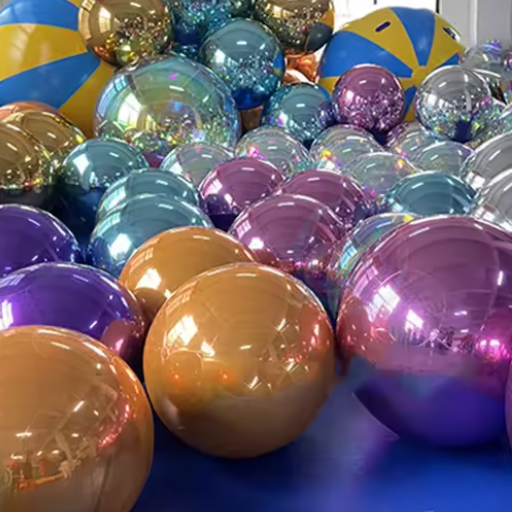Helium balloons lend an air of enchantment to every celebration, an indefinite lyrical joy poured into the occasion. Given the details above, Many felt disappointed in the sight of these festive decorations withering or drowning before the lot even got underway. Can one keep these colorful wonders afloat and in tip-top condition for a long time? Certainly! This guide imparts some practical hints and tricks to help keep helium balloons lofty and inflated until dawn, so you may enjoy your celebrations without worrying about drooping décor. Whether this special event is for an occasion or just for fun, you will have every solution to make these balloons stand the test of time right here!
Why Do Helium Balloons Deflate Overnight?

There are helium balloons that deflate overnight because helium atoms, being very light and tiny, can escape from the surface of the balloon material. Often, latex balloons are quite porous when it comes to the passage of helium gas, allowing it to leak slowly. Also, temperature changes will cause the helium gas in the balloon to contract and make it appear deflated in cooler environments. High-quality or specially coated balloons will act as a barrier to this process for a little while.
Understanding Helium Gas and Its Properties
|
Category |
Key Point |
|---|---|
|
Physical Properties |
Colorless, odorless, tasteless noble gas. |
|
|
Atomic number is two. |
|
|
Boiling point is −268.9°C. |
|
|
Melting point is −272.2°C at 26 atm. |
|
|
Lowest density at 0.1785 g/L (STP). |
|
|
Critical temperature is 5.19K. |
|
|
Exists as gas, except at extreme cold. |
|
Chemical Properties |
Very low reactivity, inert gas. |
|
|
Electron configuration is 1s². |
|
|
Completely nonflammable. |
|
|
Does not form stable chemical compounds. |
|
Isotopes |
Has two stable isotopes, helium-3 and helium-4. |
|
|
Helium-4 is vastly more abundant. |
|
Uses |
Inflates balloons, blimps, and research instruments. |
|
|
Coolants for MRI and superconductors. |
|
|
Used in cryogenics for extremely low temperatures. |
|
|
Leak detection in industrial pipelines. |
|
|
Protective gas for arc welding processes. |
|
|
Fuel pressurization in rockets. |
|
Source |
Extracted from natural gas deposits. |
|
Environmental Notes |
The second most abundant element in the universe. |
|
|
Escapes Earth’s atmosphere due to low weight. |
|
Safety |
Can cause asphyxiation in enclosed spaces. |
|
|
Contact with liquid forms increases the risk of frostbite. |
The Role of Latex and Foil Materials
The materials used to create latex and foil balloons are essential considerations for how well the balloons stand the test of time, especially when helium is involved. Latex is a natural, elastic material derived from rubber that makes it highly stretchable yet biodegradable. Since it is porous, helium atoms, being incredibly small, disintegrate through the material slowly over time. Under normal conditions, helium latex balloons can float for about 8-12 hours, though such a time is variable depending on atmospheric temperature or humidity.
Foil-type balloons consist of a thin metalized polyethylene material. Such material is much less porous than latex, thus slowing down helium leakage considerably. Hence, foil balloons usually stay inflated for days or even weeks. According to officials from balloon manufacturers and suppliers, a standard Mylar balloon can retain helium for 5-7 days; meanwhile, some finer quality might go as far as retaining helium for 2 weeks. Moreover, temperature changes have less impact on foil balloons compared to latex. Therefore, weather changes or outdoor conditions would better suit foil balloons.
New balloon technology developments have given birth to specially coated latex balloons that help reduce helium loss. These coatings reduce the material’s porosity and extend the float time of helium-filled latex balloons by a few hours. Merging these latest technological advances with great foil designs has allowed manufacturers to produce balloons that offer great value in affordability, durability, and performance for various uses, from casual parties to corporate promotions.
How to Keep Helium Balloons from Deflating Overnight?
I always consider the highest quality materials when giving balloons the helium lift to keep them from deflating overnight; these materials could be foil balloons or latex balloons with some kind of special treatment that serves as a coating to slow helium loss. I also keep balloons away from heat extremes, since they can cause expansion and popping; cold, conversely, makes helium contract and impairs its float time. When I can, I seal latex balloons with Hi-Float, which really does extend float time. By doing these little things, I can ensure the balloons stay inflated and look good for longer!
What Are the Best Tips to Make Helium Balloons Last Longer?

- Select High-Quality Balloons: Use durable balloons, such as foil or treated latex, to avoid excessive helium loss.
- Proper Inflation: Balloons must be inflated to the correct size to avoid excess expansion, which might cause them to burst.
- Use Hi-Float for Latex Balloons: You can treat latex balloons with a product extending float time by forming a protective seal.
- Avoid Extreme Temperatures: Heat expands balloons to create pop; cold shrinks helium and works against float time.
- Store and Transport with Care: Ensure protection against any puncturing object and ensure their careful handling.
- Secure the Balloons: A good knot and weights are necessary to safeguard the balloons from floating away or from exposure to the outdoors.
Using Hi-Float for Latex Balloons
Hi-Float is a fantastic product for keeping latex balloons floating longer and making them look full and bright. Hi-Float is a patented liquid meant to coat the inside of the latex balloons to form a barrier that slows down the escape of helium gas. Here are five essential features and benefits of Hi-Float:
- Longer Float Time: Balloons treated with Hi-Float float up to 25 times longer than untreated balloons, making Hi-Float perfect for event decorations that need to remain intact longer.
- Easy to Apply: Hi-Float comes with dispensers that allow you to easily apply the solution evenly onto the inside of the balloon before inflation.
- Works with Various Sizes: Hi-Float works for latex balloons of all sizes, enabling more flexibility in arrangements.
- Safe and Non-Toxic: The material is non-toxic, biodegradable, and suitable for all occasions.
- Versatile: It can operate in different environmental conditions, which applies to maintaining the longevity of balloons indoors and outdoors.
Hi-Float will ensure that your balloon decorations look good throughout the event and lessen the need for balloon replacements during the event.
Choosing Between Latex and Foil Balloons
|
Category |
Latex Balloons |
Foil Balloons |
|---|---|---|
|
Material |
Made from natural rubber, biodegradable. |
Made from metalized plastic, non-biodegradable. |
|
Durability |
Deflates faster, lasts 1-3 days. |
Retains helium longer, lasts up to 1-2 weeks. |
|
Customization |
Basic shapes; wide color options. |
Intricate shapes; detailed designs possible. |
|
Cost |
More affordable, ideal for bulk use. |
More expensive due to production precision. |
|
Environmental Impact |
Degradable, less harmful. |
Non-degradable, can pollute. |
|
Event Suitability |
Best for short-term events. |
Suitable for long-term events. |
|
Helium Retention |
Loses helium quickly. |
Retains helium efficiently. |
|
Shapes Available |
Limited to basic shapes. |
Offers creative, complex shapes. |
|
Reusability |
Single-use, often disposable. |
Some reusability with care. |
|
Production |
Requires no advanced technology. |
Made with advanced sealing technology. |
Correctly Knotting and Sealing Your Balloons
Stretch the neck of the balloon firmly, knot it securely near the fully inflated base, and if you’d like to strengthen the seal, use a clip or double seal; this way, your balloons will stay afloat for longer periods.
How Can Balloon Artists Ensure Balloons Last Overnight?

Balloons can last the entire night by storing them in a cool and dry place away from sunlight and extreme temperatures, as heat expands the balloons and they burst. Purchase high-quality balloons for longevity, and apply a professional sealant for less air seepage. Do not overinflate them, as this can make them more likely to pop. Knot them tightly and, if possible, double seal; this helps. Proper preparation and handling will ensure their look and shape through the night.
Optimal Inflation Techniques
When properly inflated, balloons have the potential to last fully in life and stay appealing to the eye. When selecting the correct equipment, there must be an original inflation method. Electric or hand pumps of good quality allow control, intending to ensure the balloons do not get overinflated. Balloons should then be inflated to their intended size, which should be mentioned in the package if impossible. For instance, an ordinary 11-inch latex balloon should be inflated to have 11 inches in diameter. Measuring balloons with a template or balloon sizer is preferred over relying on eyesight for accuracy and consistency.
Some care should be taken with the inflation levels of helium balloons. It is somewhat accepted that helium balloons, when underinflated to about 90-95 percent of the intended size, may better withstand a period of exposure to heat, thereby avoiding rupture. Foil balloons require particular handling since overinflation might create creases or tears along the seams from which air or helium can escape.
Recent correlations between studies point to using treatments like Hi-Float for latex balloons about longevity concerns. A hi-float can extend the float time of helium-filled latex balloons 25 times over and longer than untreated ones so that some balloons will float for several days instead of hours.
Finally, perform a “squish test” after inflating the balloons: a well-inflated balloon feels firm but yields a little to light fingertip pressure, ensuring that balloons stay functional, durable, and visually appealing for any event or celebration.
Storing Balloons in Ideal Conditions
|
Category |
Key Point |
|---|---|
|
Temperature |
Store between 68-72°F (20-22°C) for longevity. |
|
Humidity |
Keep in low humidity to minimize latex weakening. |
|
Light Exposure |
Avoid sunlight; store in dark, shaded areas. |
|
Storage Environment |
Cool, dry, and dust-free spaces are ideal. |
|
Protection |
Use airtight opaque containers for uninflated balloons. |
|
Transport Tips |
Avoid storing in vehicles with fluctuating temperatures. |
|
Inflated Balloons |
Store away from heat and sharp objects. |
|
Additives |
Use Hi-Float for latex balloons to retain helium. |
|
Freezing |
Freezing optional for uninflated storage; thaw before use. |
|
Rotation |
Rotate stock every few months for freshness. |
Preventing Helium Leaks and Diffusion
Leakage and diffusion can be prevented by selecting high-quality balloons made of materials such as latex or mylar, which allow fewer pores. Also, it is better to tie the balloons tightly or use balloon sealing clips to trap the helium. The balloons must then be kept in a cool, dry location away from sharp objects or moist places that might cause them to expand and suffer a leak. All these measures extend the balloon’s life and further prevent any loss of helium.
Do Larger Balloons Last Longer Than Smaller Ones?

Indeed, given the greater diameter of the larger balloons, helium tends to keep them longer. However, larger balloons provide greater outer volume and mildly thicker walls that retain helium more efficiently. On the other hand, small balloons lose helium more rapidly due to their high surface area to volume ratio, which increases helium diffusion. So, bigger balloons will be a better option for more extended retention periods.
The Science Behind Balloon Size and Helium Retention
The size of the balloon is the determining factor in how long helium can be retained inside it, considering the laws of physics and material science. Helium atoms are very small, which facilitates their escape through the microscopic pores of the balloon material with time. Larger Balloons, especially Latex or Foil, have a thicker surface but also a bigger internal volume to accommodate helium longer than smaller balloons.
More recent studies and industry data indicate that a typical 11-inch helium latex balloon begins to visibly lose lift after 12-24 hours, while a larger 16-inch helium latex balloon can hold until the 30-36-hour mark. Foil balloons, being non-porous, will retain helium much longer and will even last anywhere from several days to weeks, depending on their size and environmental factors.
The surface-to-volume ratio comes into play. The smaller one is, the more surface it has relative to its volume, allowing more helium to escape through its material. In other words, a 9-inch one has around 254.5 sq. ft. of surface area, whereas a 16-inch one has almost 804.2 sq. ft. The second, of course, has got a much deeper volume to hold helium. This explains why smaller ones end up diffusing their helium quicker.
Ambient temperature and humidity conditions also influence helium retention. Higher temperatures cause helium to expand, thereby creating more internal pressure in the balloon and hastening its diffusion through the balloon material. For higher helium retention, balloons should be stored in a cool, shaded area.
Also, from manufacturer data, it is inferred that using a sealant or high-quality materials such as metallic foil can greatly extend the life of helium balloons. For instance, foil balloons reportedly lose only 1-2% helium in volume each day under optimum conditions, thereby making them suitable for long-term displays.
This data may help in choosing balloons for specific occasions so that they stay fully inflated and attractive throughout the celebration.
Comparing Float Times of Various Balloon Sizes
| Balloon Type | Size | Float Time | With Hi-Float | Notes |
|---|---|---|---|---|
|
Latex Balloons |
9 inches |
8-9 hours |
Not specified |
Porous material, helium escapes faster. |
|
Latex Balloons |
10 inches |
8-10 hours |
Not specified |
Inflate close to event time. |
|
Latex Balloons |
12 inches |
6-12 hours |
Up to 20 hours |
Hi-Float extends duration significantly. |
|
Latex Balloons |
36 inches |
Up to 20 hours |
Not specified |
Larger size holds more helium. |
|
Foil (Mylar) Balloons |
18 inches |
3-5 days |
Not applicable |
Airtight, retains helium longer. |
|
Bubble Balloons |
24 inches |
Up to 72 hours (3 days) |
Not applicable |
Durable material, long-lasting. |
How Does Temperature Influence Helium Balloons?

Temperature plays a significant role in the balloons. When cooled down, the helium molecules undergo contraction inside the balloons, resulting in shrinking and an appearance of partial deflation. In contrast, at high temperatures, helium expands, causing the balloon to possibly overinflate and hence be prone to bursting. It would thus be great if balloons could be kept in moderate temperatures at all times to keep their shape and float duration effectively.
Effects of Cold and Hot Weather on Balloons
| Weather Condition | Effect on Balloons | Key Points |
|---|---|---|
|
Cold Weather |
Shrinkage and deflation |
Helium contracts, reducing volume1. |
|
|
Material brittleness |
Latex and mylar become fragile. |
|
|
Temporary recovery indoors |
Balloons regain shape in warmth. |
|
Hot Weather |
Expansion and popping |
Heat expands air, increasing pressure. |
|
|
Material deterioration |
Direct sunlight weakens balloon material. |
|
|
Overinflation risk |
Overfilled balloons burst more easily. |
Temperature-Controlled Storage Solutions
To prevent helium balloons from severe temperature fluctuations, specific solutions have been developed to maintain temperature consistency for the longevity of these balloons. These windows of opportunity close upon the hot and cold weathers, lengthening the integrity of the balloons. Here are five very effective temperature-controlled storage options.
- Climate-Controlled Storage Units
These storage units provide heating and cooling to attain stability in temperature conditions usually between 60°F and 75°F (15°C and 24°C). They are perfect for storing huge amounts of helium balloons.
- Insulated Storage Containers
Such containers have materials that resist the transfer of heat and thus maintain the consistency of either external conditions or a certain temperature setup within the container. They can be carried around on the go, making them useful for temporary storage during transport or an event.
- Refrigerated Balloon Cabinets
These cabinets, designed explicitly for balloons, keep exact temperature and humidity levels to prevent either shrinking or overexpansion of helium gas.
- Cooler Bags with Ice Packs
These bags will keep temperatures at bay in hot scenarios in the short term, preventing the balloons from being overinflated on the way or outdoors.
- Temperature Monitoring Systems
Digital systems can monitor temperature conditions around the clock, make immediate adjustments, and alert the user of any impending temperature shift to save the balloons in storage.
References
- Ballooning across the curriculum – Northern Illinois University
- Abstracts from the 2016 AHAC conference – DePaul University
- The Eclipse Ballooning Project – Vanderbilt University
Frequently Asked Questions (FAQ)
Q: How can I keep helium balloons from deflating quickly?
A: To prevent your balloons from deflating quickly, store them in a cool, air-conditioned environment and avoid exposing them to direct sunlight. This helps prevent the helium molecules from expanding and escaping quickly.
Q: What are some tips to make balloons last longer?
A: Using high-quality materials such as Mylar or Qualatex balloons can make balloons last longer. These materials are less porous and help keep helium from escaping. Also, consider using a product like Hi-Float inside the balloon to extend the life of latex helium balloons.
Q: How long do helium balloons last?
A: Helium balloons generally last between 8-12 hours for latex and 2-5 days for foil helium balloons. However, with proper care and conditions, you can keep helium balloons afloat for longer.
Q: How can I inflate helium balloons to ensure they last overnight?
A: For balloons to last overnight, ensure they are fully inflated and tie them securely to prevent helium from escaping. Using a product like Hi-Float on the inside of the balloon can also help them stay afloat longer.
Q: Can I keep helium balloons indoors to make them last much longer?
A: Yes, keeping helium balloons indoors in a stable, cool environment can significantly help them last longer. Avoid areas with sharp objects or rough surfaces that might puncture the balloons.
Q: What is the best way to extend the life of latex helium balloons?
A: To extend the life of latex helium balloons, treat the inside of the balloon with a product like Hi-Float before inflating. This creates a coating that slows down the helium escape through the porous material of the balloon.
Q: How can I ensure my party balloon decorations last throughout the event?
A: To ensure your party balloon decorations last throughout the event, keep balloons in a calm environment, handle them gently to avoid popping, and use high-quality materials like mylar or bubble balloons.
Q: Are there specific types of balloons that keep helium longer?
A: Foil or mylar balloons generally keep helium longer than latex balloons because they are less porous and provide a better barrier against helium atoms escaping.
Q: Can I use helium to inflate many balloons for a larger decoration setup?
A: Helium can inflate many balloons for a larger decoration setup. However, it’s essential to consider the size and type of balloons to ensure they will last for the duration of your event.
Q: What can cause helium balloons to lose their float longer than expected?
A: Factors such as exposure to heat, direct sunlight, and rough handling can cause helium balloons to lose their float sooner than expected. Keeping balloons in optimal conditions can help them stay afloat as intended.









